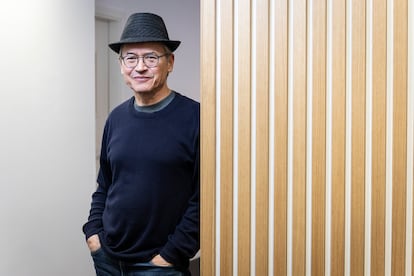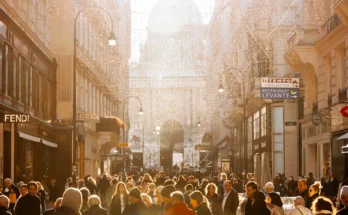What is most surprising in a face to face with Joe Sacco is that he has eyes behind his glasses. The famous journalist and cartoonist, author of comics (a name he prefers to that of a graphic novel) memorable in the history of the genre, such as Palestine, Gorazde: protected area, The Mediator: a story from Sarajevo o The war in Gazahe laughs when he tells her this. “I have them, yes, drawing myself without eyes in my stories is a convention. If you look at my early works, all the characters were a bit like that, a bit grotesque, influenced by comics.” subway and alternative of the seventies and of Sergio Leone and his close-ups westernin which you saw the pores of the skin and the defects of the faces. Over time I understood that if you want to have journalistic verisimilitude you have to draw more realistically, people as they are. So I had to force my hand, which is not comfortable for me. Someone then pointed out to me that it made people more realistic but not me. The truth is, I didn’t realize it. He kept drawing me like a quick sketch. Now I’m improving, but always with that white behind the glasses, which has something of self-parody and also of self-protection, of not showing my emotions.”
In any case, in reality the dark and intelligent eyes of Sacco (Kirkop, Malta, 64 years old), a comics reporter, are impressive: they are the same ones that have looked at the pain, devastation, hatred and death in Gorazde, Sarajevo, Gaza or now in the cities of Uttar Pradesh, in northern India, to whose interreligious conflicts between Hindus and Muslims he dedicates his new work The eternal disturbance (Reservoir Books, Penguin, 2025, translated by Montse Meneses Vilar). What interested you about this story? “I had worked before in India, on rural life, and I was looking for an excuse to return. A colleague told me about those riots and I found it very interesting to find out what had happened. I thought about it, I didn’t want just any story, it seemed better to do a story about history, about what people tell to explain what they did in such a situation.” For Sacco the essential topic of his book is “the difficulty of finding the truth”. At the beginning, he points out, “you don’t have it, you have the story.” And he underlines that the fundamental work of journalism is “digging to get to the truth, on the surface there are only lies”.
At the origin of the Uttar Pradesh riots of 2013 which Sacco went to investigate and which have their roots in the partition of India in 1947 and risk being prolonged, there is a rape, that of a 16-year-old Muslim girl which sparked – after resulting in a murder and a lynching – the conflict between the Jats (a predominantly Hindu ethnic group) and the Muslims. Sacco does not draw rape, which is taboo for him. “I’ve never done it, you can’t stop it from happening, in arguments between men women always end up suffering, but I never wanted to draw them. I have an average sensitivity, certain things repel me, disgust me. I’m very careful when I reproduce situations of violence. Drawing a rape would mean exceeding my limits, which I believe are quite the same as those of my readers.”
What Sacco draws, and masterfully, in The eternal disturbance They are the masses, Hindus and Muslims, on foot or in means of transport such as trucks or tractor trailers. Creepy and threatening crowds, armed with clubs, swords, knives, homemade firearms or lathisthe emblematic traditional Indian walking sticks. “I try very hard, it is essential to draw the crowd well. Some artists limit themselves to drawing the people in the front rows and then hide the rest, those behind, with a few strokes. I want the reader to feel the mass. And see each face, to understand that they are human beings who make up the crowd, recognisable, each son of his father and mother. I try to give everyone a personality. I went to see the places where those uncontrollable mass demonstrations took place. And angry and I took photos like that. I could reconstruct the physical environment.”
In the cartoons in which these crowds move, Sacco introduces reflections on the dynamics that lead the group to become an angry mass. Have you read Elias Canetti? “Mass and power?, I have it, and Mass psychologyby Gustave Le Bon, but I deliberately decided not to read them until I finished the book, so as not to influence myself.
Sacco considers himself above all a journalist. “It’s what I studied, and I think as a journalist. I didn’t train as a comedian journalist because there was no such thing. I remember that when in class we talked about war correspondents or those who worked abroad, it very intimidated me. They seemed omnipresent and omnipresent, like flies on the ceiling that had a complete vision of events. Then, when I was also in the field, I understood that in reality no one can have that omniscience, that we all use local informants and journalists. (Sacco dedicates The eternal disturbance to “India’s hard-working rural journalists” and many of whom are profiled in the album). We all need other people if you want to get the whole story. In this sense, I try to show the seams, the stitches of journalism”. The journalist and cartoonist underlines that “journalism is not a science, but a practice of fallible human beings”.
His system is to take lots of notes on sitegoing into places and talking to witnesses, and also taking photos, to draw later. “My work is no different from yours, from that of any journalist. I draw nothing or very little on the ground. But it is true that I try to obtain visual data, information that then helps me draw.”
At the same time, Sacco was created The eternal disturbance with that of The Gaza War. “It was difficult, I dedicated four or five days to the history of India and two to the history of Gaza. It was complicated because Gaza was current but I also had a great responsibility with the other history. They are different stories of violence. Immersing myself in both was painful. You wonder what the hell is happening to human beings to behave like this.” For Sacco, the story of Gaza was simpler, “it was clearer in my head, India is an immense place, with a population of a billion people and a variety that is very difficult to assimilate.” Precisely The eternal disturbance shows a pedagogical desire to bring the reader closer to a very complex conflict. “I always try to set up the story so that it is understandable, starting with me. In this sense, I consider myself the first reader.”

Joe Sacco, who by the way has nothing to do with the famous anarchist Nicola Sacco (“Anyway, I would prefer to be related to Bartolomeo Vanzetti, a more interesting character, his letters in prison awaiting execution are moving”), has a long family relationship with war, one of the themes of his albums. “My mother told me what it was like to live in Malta during the Second World War, where she suffered the terrible Italian and Nazi siege. My father also talked about the war, they both did it without problems. I understood how easy it is for life to be interrupted by a war. I also grew up in Australia, where the memory of the two world wars is very present in the national consciousness.” Sacco believes there is no simple answer to why war exists. “I understand that sometimes people need to defend themselves, I’m not a pacifist. But when the shootings start everything collapses. In reality in war you can’t give rules and everything becomes corrupted. It’s the ultimate shame of the human species.”
One of Sacco’s most unique creations was THE Great Wara graphic representation in a 7 meter leaflet of the first day of the Battle of the Somme, 1 July 1917, a work inspired by the Bayeaux Tapestry. “Jacques Tardi is the master of drawing the First World War, but what influenced me was the Australian national connection to that war, Gallipoli, etc. When I made that comic I started to question human nature, my work is very much based on individual experience but in war you see the creation of a community to kill others. I always think about what an alien watching trench warfare at that time would see: people killing each other in an impersonal way.”
Sacco lured Nixon. Don’t feel like doing it with Trump? “I got Nixon involved Boomfin which the president is resurrected as Obama. I have plans for Trump. What if it’s hard to draw? Not really, people who have more standardized traits are more difficult. Trump’s physique, his gestures and his posture make him easily recognisable.” Are you tempted? “Yes, of course, but you have to think very carefully about what to do with him, it’s not easy to do something original with someone whose speeches seem to be written by a comedy screenwriter. The question is how to get something interesting from someone like that.
As a leftist who has already found things to criticize Obama about, the Trump era must be a torment. “He criticized Obama and Biden because they were paving the way for someone like Trump. In their administrations, the United States was already sinking into darkness and Trump is now. Trump didn’t change everything in one day. Things don’t work that way.”
Joe Sacco is a self-confessed admirer of bizarre journalism and Hunther S. Thompson. “They definitely influenced me a lot. Thompson understood how the American electoral system really worked when he covered the 1972 election. He understood the mechanics and explained it in a funny way and said ‘shit!’. I think that combination is fantastic. I’m also a big fan of Michael Herr. In war dispatches I could taste Vietnam in my mouth. What a wonderful way to evoke it! It inspired me a lot. The feeling of being there.”
Whom he considers one of his teachers, Art Spiegelman doesn’t dare say if he has changed his mind about who cats and mice are today. “You should ask him; be careful with metaphors, I shouldn’t speak for him.”
Is there any reason for optimism in Gaza today? “If you want to narrow down optimism you might think that at least the world at large has more empathy for the Palestinians and wonders why Western governments allowed genocide. I can’t speak for the people of Gaza either. But I think they don’t know what future awaits them, they are in existential limbo. They could be expelled or Israel launch another offensive at any moment.”
He doesn’t like the term “graphic novel” which sounds like “marketing sell comics to adults and make them feel good”, but believes that it is “a semantic struggle that we have already lost”. Superhero comics, moreover, “don’t interest me, as a child I barely read them, a couple of Superman and some The GhostThe masked man). And he underlines: “I have never been interested in people who always win, this didn’t seem true to me even as a child.” He recognizes that superheroes are part of “the ecology of comics” and are necessary to provide economic support to the rest of the industry, “and there’s always the hope that kids who read superheroes will move on to more serious comics.”



